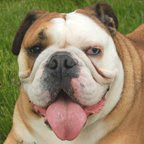
BARRINGTON'S DOG BLOG
HIS BREED'S HISTORY DICTATES THAT HE'S HERE TO GO HEAD-TO-HEAD WITH THE BULLS, BUT THIS LITTLE GUY JUST WANTS TO SPREAD THE LOVE!
BARRINGTON

BARRINGTON'S PROFILE
AGE: 6
COAT: Short hair, tan/white/brown
OBSESSED WITH: Sumo wrestling
LIKES: Dr.Pepper, flannel, Breathe Right Nasal Strips
DISLIKES: Giraffes, skyscrapers, Randy Newman
GUILTY PLEASURE: His Hello Kitty humidifier
DISTINGUISHING CHARACTERISTIC: Tight gams
WTW CLIENT SINCE: 2008
FUN FACTS ABOUT BULLDOGS
The bulldog's specific traits can (but not always) contribute to some specific health issues. Breathing issues can be prevalent in the breed due to the shape and the shortness of muzzle. Most noticeably, bulldogs are known to snore loudly.
Like all dogs, bulldogs require daily exercise. If not properly exercised the bulldog could gain weight, which could cause health problems relating to the lungs and heart. Bulldogs are extremely sensitive to heat and great care should be given to the dog during overly warm periods. During these times, the owner must ensure that the dog has plenty of shade and water, and bulldogs must be kept out of standing heat.
While some canine breeds have their tails cut soon after birth, Bulldogs are one of very few breeds whose tail is naturally small and curled, and can appear as though they do not have one. A longer or "gay" tail is a serious fault in a show bulldog. The tail of some can be so tight to the body that regular cleaning and maintenance is recommended.The term "bulldog" was first used around 1568 and might have been applied to various ancestors of modern bulldog breeds. It has been theorized that Bulldogs were bred in England as a cross between the mastiff and the pug, although their genetic origin is debated.[2]
In the 1600s, bulldogs were used for bullbaiting (as well as bearbaiting), a gambling sport popular in the 17th century with wagers laid in which trained bulldogs leapt at a bull lashed to a post, latched onto its snout and attempted to suffocate it.[3] Bulldogs were not needed after these sports were outlawed, and so the original athletic bulldog was crossed with pug. The outcome was a shorter, wider dog with a brachycephalic skull. Though today's bulldog looks tough, he cannot perform the job he was originally created for, as he cannot withstand the rigors of running and being thrown from a bull, and cannot grip with such a short muzzle.
NOTABLE BULLDOGS
- Disney has Butch the Bulldog as a bully to Pluto.
- Disney's Oliver and company has Francis the Bulldog.
- In Looney Tunes there are three bulldogs: Hector the Bulldog (a supporting character in some Sylvester/Tweety cartoons), Spike (always seen with a terrier named Chester), and Marc Antony (always seen with a kitten named Pussyfoot).
- Tom and Jerry have Spike the Bulldog and Tyke, his son as recurring characters.
- Droopy has Butch the bulldog as an antagonist.
- Tiny Toons has Barky Marky mirroring Marc Antony and the other Looney Tunes bulldogs.
- Jonny Quest has a bulldog pet named Bandit.
- In Thundercats, Mum-ra, their main foe, has a bulldog pet named Ma-Mutt.
- In Veronica's Closet the main character has a bulldog pet in the earlier seasons.
- In MacGyver there is a bulldog named Frog.
- In Mr. Magoo there is a bulldog named Angus.
- The Batman films directed by Joel Schumacher feature a bulldog in odd scenes.
- In Seinfeld Kramer sets a bulldog to chase Newman, perpetuating the stereotypes of dogs chasing mailmen and bulldogs as aggressive dogs.
- In Little Nicky the main character is advised by Mr. Beefy, a demon bulldog.
- In Jake and the Fatman there is a bulldog named Max.
- In Rob and Big and Fantasy Factory Rob Dyrdek owns a white bulldog, Meaty and later a bulldog named Beefy.
- 70s pop duo Captain & Tennille often featured their pet bulldogs, Broderick and Elizabeth, on their album covers.
- During World War 2, Winston Churchill was commonly referred to as the "British Bulldog" and was often characterized as one in cartoons at the time.
- Pete Wentz has a bulldog named Hemingway who is best known for Fall Out Boys video clip "the take over, the breaks over" revolving around him.
- In Everybody Loves Raymond, Robert (Brad Garrett) had a bulldog named Shamsky (after the baseball player) for the first three seasons of the show.
- In National Lampoon's Van Wilder: The Rise of Taj, the main character Taj Mahal Badalandabad had a bulldog called Ballzac.



